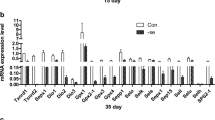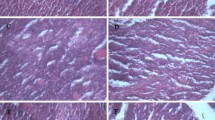Abstract
The aim of the present study was to investigate the effect of selenium (Se) deficiency on the expression of the toll-like receptor (TLR) signal transduction pathway in the spleen of chickens and explore the relationship between the TLR4/TRIF/NF-κB signaling pathway and inflammatory spleen injury. A total of 200 one-day-old healthy broilers were allocated to two groups. The experimental group was fed a self-made low-Se diet (0.004 mg/kg) while the control group was fed a complete formula feed (0.2 mg/kg) for 15, 25, 35, 45, and 55 days, respectively. We observed histopathological changes in the chicken spleens. The messenger RNA(mRNA) expression levels of 8 kinds of ChTLRs, myeloid differential protein-88 (MyD88), toll-interleukine-1 receptor domain-containing adapter-inducing interferon-β (TRIF), nuclear factor-κB (NF-κB), and cytokine (IL-6, TNF-α, IL-2, and IFN-γ) were detected via quantitative real-time PCR. Western blotting was used to detect the protein expression level of TLR4. Then principal component analysis (PCA) was used to analyze the correlation between the ChTLRs, MyD88, TRIF, and NF-κB. The results showed that the boundary between red pulp and white pulp was unclear, the number of lymphocytes decreased, and the nucleus was fragmented and dissolved in the experimental group at 25–55 days. At 15–45 days, the relative expression of TLR4 mRNA was higher than in the control group, and the difference was extremely significant on day 15 (P < 0.01).The relative expression of TRIF mRNA in the experimental group was higher than in the control group at 25–55 days, and the relative expression of NF-κB mRNA in the experimental group was higher than in the control group at 15–45 days. The relative expression of IL-6 mRNA in the experimental group was higher than in the control group at 15–45 days. The protein expression level of TLR4 in the experimental group was higher than in the control group at 15–45 days. The PCA results showed that there was a strong correlation between TLR4, TRIF, and component 1. The results suggest that TLR4 plays an important role in regulating the expression of inflammatory cytokines in the spleens of Se-deficient chickens, and Se deficiency may cause inflammatory injury through the TLR4/TRIF/NF-κB signaling pathway in chicken spleen.








Similar content being viewed by others
References
Licata P, Trombetta D, Cristani M, Giofrè F, Martino D, Calò M, Naccari F (2004) Levels of “toxic” and “essential” metals in samples of bovine milk from various dairy farms in Calabria, Italy. Environ Int 30:1–6
Khoso PA, Zhang Y, Yin H, Teng X, Li S (2019) Selenium deficiency affects immune function by influencing selenoprotein and cytokine expression in chicken spleen. Biol Trace Elem Res 187:506–516
Yang Z, Liu C, Liu C, Teng X, Li S (2016) Selenium deficiency mainly influences antioxidant selenoproteins expression in broiler immune organs. Biol Trace Elem Res 172:209–221
Wan N, Xu Z, Chi Q, Hu X, Pan TR, Liu T, Li S (2019) microRNA-33-3p involved in selenium deficiency-induced apoptosis via targeting ADAM10 in the chicken kidney. J Cell Physiol 234:13693–13704
Xu SW, Yao HD, Zhang J, Zhang ZW, Wang JT, Zhang JL, Jiang ZH (2013) The oxidative damage and disbalance of calcium homeostasis in brain of chicken induced by selenium deficiency. Biol Trace Elem Res 151:225–233
Liu Q, Cai J, Gao Y, Yang J, Gong Y, Zhang Z (2018) miR-2954 inhibits PI3K signaling and induces autophagy and apoptosis in myocardium selenium deficiency. Cell Physiol Biochem 51:778–792
Thompson JN, Scott ML (1970) Impaired lipid and vitamin E absorption related to atrophy of the pancreas in selenium-deficient chicks. J Nutr 100:797–809
Yang Z, Liu C, Zheng W, Teng X, Li S (2016) The functions of antioxidants and heat shock proteins are altered in the immune organs of selenium-deficient broiler chickens. Biol Trace Elem Res 169:341–351
Pan T, Liu T, Tan S, Wan N, Zhang Y, Li S (2018) Lower Selenoprotein T expression and immune response in the immune organs of broilers with exudative diathesis due to selenium deficiency. Biol Trace Elem Res 182:364–372
Huang Z, Rose AH, Hoffmann PR (2012) The role of selenium in inflammation and immunity: from molecular mechanisms to therapeutic opportunities. Antioxid Redox Signal 16:705–743
Miyake K (2007) Innate immune sensing of pathogens and danger signals by cell surface toll-like receptors. Semin Immunol 19:3–10
Milanesi S, Verzola D, Cappadona F, Bonino B, Murugavel A, Pontremoli R, Garibotto G, Viazzi F (2019) Uric acid and angiotensin II additively promote inflammation and oxidative stress in human proximal tubule cells by activation of toll-like receptor 4. J Cell Physiol 234:10868–10876
Hoth JJ, Wells JD, Brownlee NA, Hiltbold EM, Meredith JW, McCall CE, Yoza BK (2009) Toll-like receptor 4 dependent responses to lung injury in a murine model of pulmonary contusion. Shock 31:376–381
Wang H, Wang Q, Yang M, Yang L, Wang W, Ding H, Zhang D, Xu J, Tang X, Ding H, Wang Q (2018) Histomorphology and innate immunity during the progression of osteoarthritis: does synovitis affect cartilage degradation? J Cell Physiol 233:1342–1358
Liu Z, Qu Y, Wang J, Wu R (2016) Selenium deficiency attenuates chicken duodenal mucosal immunity via activation of the NF-κb signaling pathway. Biol Trace Elem Res 172:465–473
Youn HS, Lim HJ, Choi YJ, Lee JY, Lee MY, Ryu JH (2008) Selenium suppresses the activation of transcription factor NF-κB and IRF3 induced by TLR3 or TLR4 agonists. Int Immunopharmacol 8:495–501
Zhang W, Zhang R, Wang T, Jiang H, Guo M, Zhou E, Sun Y, Yang Z, Xu S, Cao Y, Zhang N (2014) Selenium inhibits LPS-induced pro-inflammatory gene expression by modulating MAPK and NF-κB signaling pathways in mouse mammary epithelial cells in primary culture. Inflammation 37:478–485
Zhao H, Chen Z, Xie LJ, Liu GF (2018) Suppression of TLR4/NF-κB signaling pathway improves cerebral ischemia-reperfusion injury in rats. Mol Neurobiol 55:4311–4319
Wang J, Liu Z, He X, Lian S, Liang J, Yu D, Sun D, Wu R (2018) Selenium deficiency induces duodenal villi cell apoptosis via an oxidative stress-induced mitochondrial apoptosis pathway and an inflammatory signaling-induced death receptor pathway. Metallomics 10:1390–1400
Gao X, Zhang Z, Li Y, Shen P, Hu X, Cao Y, Zhang N (2016) Selenium deficiency facilitates inflammation following S. aureus infection by regulating TLR2-related pathways in the mouse mammary gland. Biol Trace Elem Res 172:449–457
Gao XJ, Tang B, Liang HH, Yi L, Wei ZG (2019) Selenium deficiency induced an inflammatory response by the HSP60-TLR2-MAPKs signalling pathway in the liver of carp. Fish Shellfish Immunol 87:688–694
Huang X, Sun B, Zhang J, Gao Y, Li G, Chang Y (2017) Selenium deficiency induced injury in chicken muscular stomach by downregulating selenoproteins. Biol Trace Elem Res 179:277–283
Dong N, Xue C, Zhang L, Zhang T, Wang C, Bi C, Shan A (2020) Oleanolic acid enhances tight junctions and ameliorates inflammation in Salmonella typhimurium-induced diarrhea in mice via the TLR4/NF-κB and MAPK pathway. Food Funct 11:1122–1132
Wang J, Lian S, He X, Yu D, Liang J, Sun D, Wu R (2018) Selenium deficiency induces splenic growth retardation by deactivating the IGF-1R/PI3K/Akt/mTOR pathway. Metallomics 10:1570–1575
Xing YJ, Zhang RH, Lv Y et al (2018) Regulation role of Wnt/β-catenin signaling pathway in heart failure of rats with selenium deficiency. J Shanxi Med Univ 49:1003–1006
Wang FX, Liu SY, Zheng X, Chen X, Lu LX, Chen B, Xiong XY, Shu HF, Yang QW, Yang H (2015) TLR1 expression in mouse brain was increased in a KA-induced seizure model. Inflamm Res 64:487–495
Jin X, Wang L, Wu HS, Zhang L, Wang CY, Tian Y, Zhang JH (2007) N-acetylcysteine inhibits activation of toll-like receptor 2 and 4 gene expression in the liver and lung after partial hepatic ischemia-reperfusion injury in mice. Hepatobiliary Pancreat Dis Int 6:284–289
Uematsu S, Akira S (2006) The role of toll-like receptors in immune disorders. Expert Opin Biol Ther 6:203–214
Ito H, Sadatomo A, Inoue Y, Yamada N, Aizawa E, Hishida E, Kamata R, Karasawa T, Kimura H, Watanabe S, Komada T, Horie H, Kitayama J, Sata N, Takahashi M (2019) Role of TLR5 in inflammation and tissue damage after intestinal ischemia-reperfusion injury. Biochem Biophys Res Commun 519:15–22
Negishi H, Endo N, Nakajima Y, Nishiyama T, Tabunoki Y, Nishio J, Koshiba R, Matsuda A, Matsuki K, Okamura T, Negishi-Koga T, Ichinohe T, Takemura S, Ishiwata H, Iemura SI, Natsume T, Abe T, Kiyonari H, Doi T, Hangai S, Yanai H, Fujio K, Yamamoto K, Taniguchi T (2019) Identification of U11snRNA as an endogenous agonist of TLR7-mediated immune pathogenesis. Proc Natl Acad Sci U S A 116:23653–23661
Nerren JR, He H, Genovese K, Kogut MH (2010) Expression of the avian-specific toll-like receptor 15 in chicken heterophils is mediated by gram-negative and gram-positive bacteria, but not TLR agonists. Vet Immunol Immunopathol 136:151–156
Bavananthasivam J, Kulkarni RR, Read L, Sharif S (2018) Reduction of Marek's disease virus infection by toll-like receptor ligands in chicken embryo fibroblast cells. Viral Immunol 31:389–396
Cole JE, Georgiou E, Monaco C (2010) The expression and functions of toll-like receptors in atherosclerosis. Mediat Inflamm 2010:393946
Akira S, Uematsu S, Takeuchi O (2006) Pathogen recognition and innate immunity. Cell 124:783–801
Li P, Xia P, Wen J, Zheng M, Chen J, Zhao J, Jiang R, Liu R, Zhao G (2010) Up-regulation of the MyD88-dependent pathway of TLR signaling in spleen and caecum of young chickens infected with Salmonella serovar Pullorum. Vet Microbiol 143:346–351
Kaczorowski DJ, Mollen KP, Edmonds R, Billiar TR (2008) Early events in the recognition of danger signals after tissue injury. J Leukoc Biol 83:546–552
Zhang Y, Zhang X, Shan P, Hunt CR, Pandita TK, Lee PJ (2013) A protective Hsp70-TLR4 pathway in lethal oxidant lung injury. J Immunol 191:1393–1403
Johnson GB, Brunn GJ, Platt JL (2003) Activation of mammalian toll-like receptors by endogenous agonists. Crit Rev Immunol 23:15–44
Mollen KP, Levy RM, Prince JM, Hoffman RA, Scott MJ, Kaczorowski DJ, Vallabhaneni R, Vodovotz Y, Billiar TR (2008) Systemic inflammation and end organ damage following trauma involves functional TLR4 signaling in both bone marrow-derived cells and parenchymal cells. J Leukoc Biol 83:80–88
Hodgkinson CP, Ye S (2008) Statins inhibit toll-like receptor 4-mediated lipopolysaccharide signaling and cytokine expression. Pharmacogenet Genomics 18:803–813
Sheng PF, Jiang Y, Zhang ZW, Zhang JL, Li S, Zhang ZQ, Xu SW (2014) The effect of se-deficient diet on gene expression of inflammatory cytokines in chicken brain. Biometals 27:33–43
Gao X, Zhang Z, Xing H, Yu J, Zhang N, Xu S (2016) Selenium deficiency-induced inflammation and increased expression of regulating inflammatory cytokines in the chicken gastrointestinal tract. Biol Trace Elem Res 173:210–218
Zhang Z, Gao X, Cao Y, Jiang H, Wang T, Song X, Guo M, Zhang N (2015) Selenium deficiency facilitates inflammation through the regulation of TLR4 and TLR4-related signaling pathways in the mice uterus. Inflammation 38:1347–1356
Pei Z, Li H, Guo Y, Jin Y, Lin D (2010) Sodium selenite inhibits the expression of VEGF, TGFβ1 and IL-6 induced by LPS in human PC3 cells via TLR4-NF-κB signaling blockage. Int Immunopharmacol 10:50–56
Acknowledgments
We thank the Laboratory of Anatomic Pathology at the College of Veterinary Medicine, Northeast Agricultural University. All of the authors read the manuscript and agreed to submit it in its current form for consideration for publication.
Funding
This study was supported by the National Natural Science Foundation of China Youth Foundation (31602028) and the Postdoctoral Foundation of Heilongjiang Province (Project No. LBH-Q19068).
Author information
Authors and Affiliations
Corresponding author
Ethics declarations
The Institution of Animal Protection and Utilization Committee at Northeast Agricultural University approved this experiment.
Conflict of Interest
The authors declare that they have no conflicts of interest.
Ethical Approval
All of the procedures used in this study were approved by the Institutional Animal Care and Use Committee of Northeast Agricultural University.
Additional information
Publisher’s Note
Springer Nature remains neutral with regard to jurisdictional claims in published maps and institutional affiliations.
Rights and permissions
About this article
Cite this article
Zhang, R., Guo, R., Liu, Q. et al. Selenium Deficiency via the TLR4/TRIF/NF-κB Signaling Pathway Leading to Inflammatory Injury in Chicken Spleen. Biol Trace Elem Res 199, 693–702 (2021). https://doi.org/10.1007/s12011-020-02173-0
Received:
Accepted:
Published:
Issue Date:
DOI: https://doi.org/10.1007/s12011-020-02173-0




